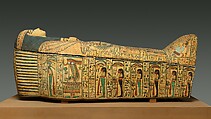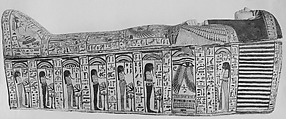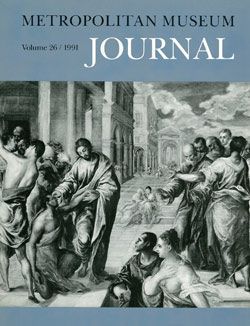Outer Coffin of the General's Charioteer, Itamun
Third Intermediate Period
The coffin set of the General's Charioteer, Itamun (this outer coffin, with an inner coffin (26.3.2a, b), and a mummy board (26.3.3) was found in a pit tomb hidden in a desolate desert valley on the West Bank at Thebes. The tomb had been used several hundred years earlier (around 1500 B.C.), and the burials of at least four women from this period had been pushed aside to make way for Itamun. His coffins were set neatly against one wall, with a canopic box for viscera resting on top. The lid of this coffin was not completely closed, as the inner coffin, made originally for a priest and copper engraver of the temple of Amun named Nesiamun, was slightly too large. Inside the coffin set was amummy board, also inscribed for Nesimamun, and the mummy. The body had been covered from waist to feet with a soft hide, perhaps from a gazelle, and a whip, broken in several pieces, was found beneath his body(26.3.2a, b). Unusually for an Egyptian, Itamun sported a full beard.
The decoration of this anthropoid coffin, and the fact that it is unvarnished and undecorated on the interior, suggests that it was made in the early 21st Dynasty. Itamun wears a long tripartite wig bound with a floral fillet. His features are fine, with arched brows and long cosmetic lines outlining his wide-set eyes. Earring holes are visible on his exposed earlobes. His arms are crossed over his chest on top of a broad festival collar, with his hands fisted. A winged figure of the sky goddess Nut is shown kneeling at the level of his abdomen, with the space above filled by the icon of a djed pillar, symbol of the funerary god Osiris, flanked by crowned falcons, winged cobras, and recumbent cows. The lower portion of the lid is divided by horizontal and vertical bands of inscription into six sections, each filled with an illustration relating to Iotefamun's afterlife. On the sides of the base, labeled by vertical inscriptions, are various funerary deities who guard the mummy during his transformation into an effective spirit able to live eternally. The goddesses Isis and Nephthys take up their usual positions at the foot and head.
The whip buried with the body supports its identification with the charioteer Itamun. The beard and animal skin also associate the individual with the Near East, the region from which Egypt had imported the horse and chariot.
Due to rights restrictions, this image cannot be enlarged, viewed at full screen, or downloaded.
This artwork is meant to be viewed from right to left. Scroll left to view more.








